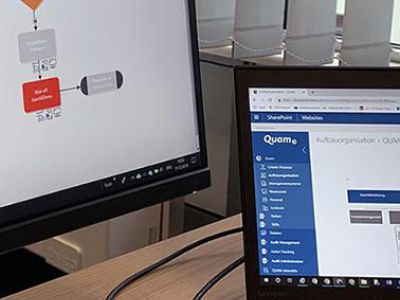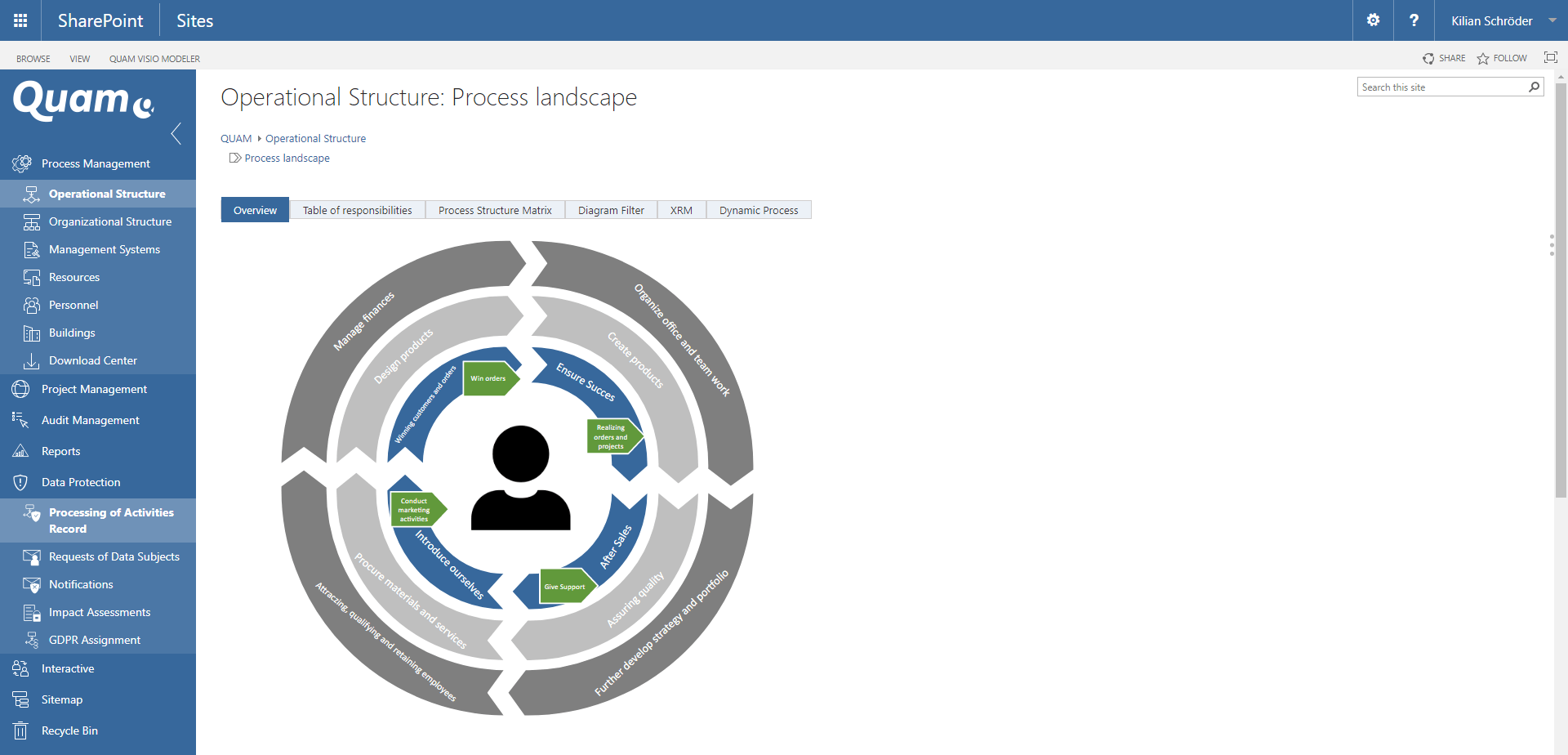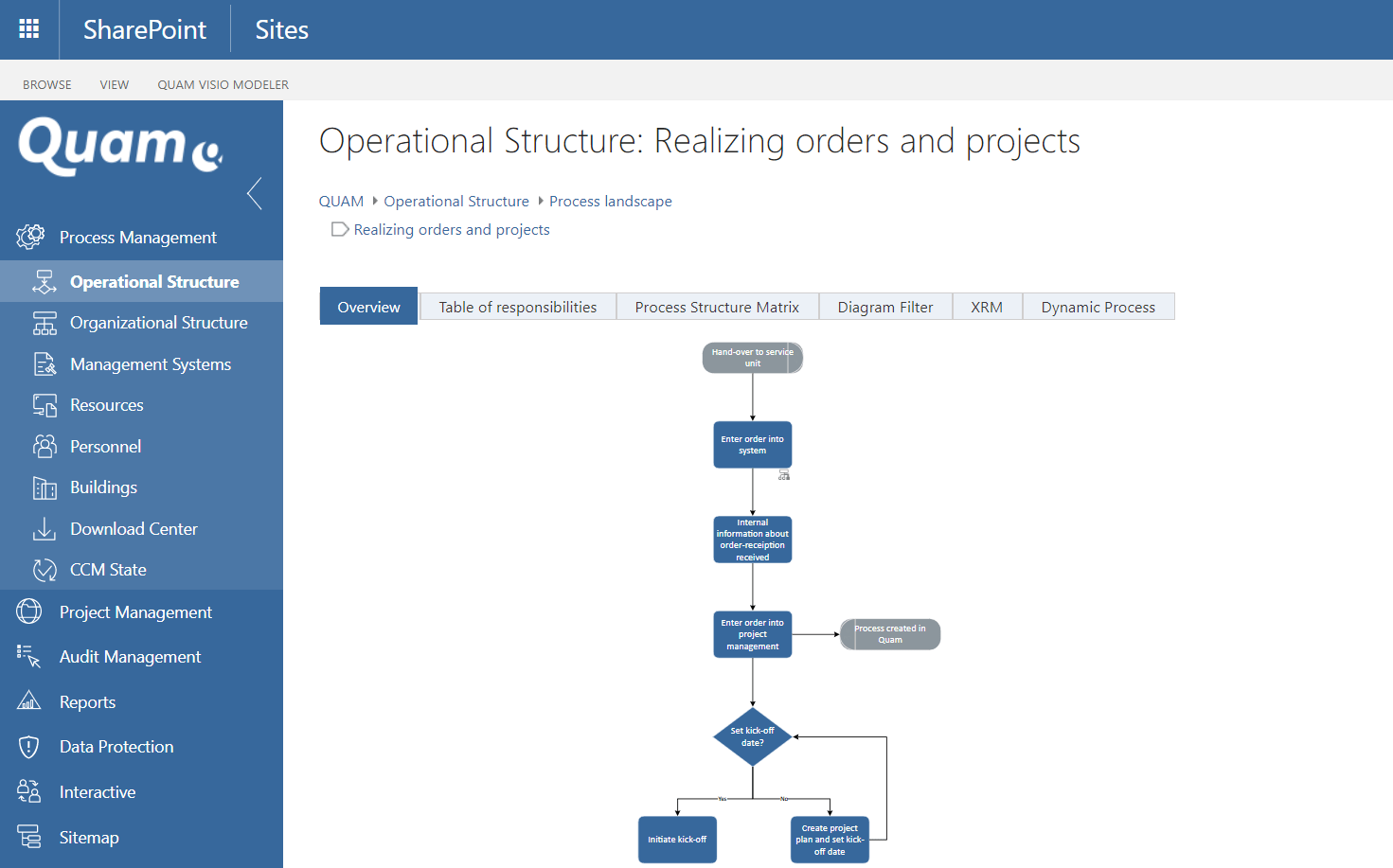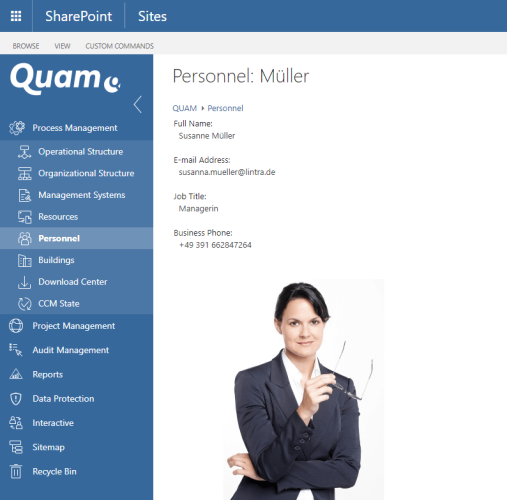
The alternative to ARIS.
The landscape of available tools for process management (BPM or GPM tools) varies from manageable to very confusing, depending on the application purpose and focus. The traditional disciplines of BPM tools - modeling and analysis - master numerous tools with very different functional depth and complexity. Aris is one of the tools that are widely used, but still do not always enjoy great acceptance among employees. With Quam, we offer an alternative based on SharePoint.
Features of BPM Tools
Process modeling and the presentation of process maps form the basis for a process portal.
Further functions such as simulation, process execution, workflow implementation and monitoring have become part of different tools that are managed in the same software category "BPM tools", but whose complexity for the end user increases to such an extent that the affected suites overwhelm most traditional users, whose main focus is the modeling, analysis and publication of process knowledge.

In addition, there are newer trends in business process management that further complement the functional scope of the process portal, such as
-
Social BPM (also referred to as BPM 2.0 - the integration of functions known from Web 2.0)
-
Risk & Compliance (i.e. the conformity of processes to rules in the company and the consideration of processes from the perspective of risk analyses)
-
Governance (ensuring that processes support corporate strategy and objectives)
-
ICS: Internal control systems (i.e. a focus on process steps for verification and confirmation) and
-
New delivery models from the cloud era, which are no longer offered as licenses for installation on the provider's own infrastructure but can be rented for use within the scope of e.g. monthly usage fees on the provider's infrastructure
The Toolset from Aris as BPM-Tool
The ARIS Toolset or ARIS Platform is Software AG's software for designing, maintaining and optimizing business processes. The software is based on the ARIS concept (Architecture of Integrated Information Systems) by August-Wilhelm Scheer (former Institute for Information Systems at Saarland University).
Market studies[1] see ARIS regularly among the GPM tools, with high distribution and great functionality. ARIS can look back on a long history of more than 20 years.
One success factor of the ARIS toolset was that many companies invested heavily in business process reengineering initiatives in the 1990s. Another success factor was the strong connection to SAP and the triumph of SAP R/3: the success of SAP also made ARIS known. ARIS is a powerful and complex tool whose models can also be executed and monitored in Software AG's webMethods product. To this extent, ARIS has inhaled parts of all the major BPM trends of recent decades, with corresponding consequences for the complexity in almost every aspect of its application. This, in turn, has the consequence that the acceptance of the employees to work with Aris is rather low. It is described as too complex and not user-friendly.

Quam - The alternative to Aris
Quam by Lintra does not copy this complexity, but instead focuses on simplicity for the user in creating even complex models and on easy accessibility of the process knowledge embodied in the models for the "consumers" of this information - which can be practically anyone in a company or organization.

With Visio as the modeling front end, modelers do not have to leave their familiar Office world to graphically edit processes (and also organizational charts, building plans, resource diagrams and other diagram types that go far beyond pure process modeling) and instead use a tool that is often part of their usual software equipment anyway. With Microsoft SharePoint as the repository for the modeled content, the pure readers of the information also move within their familiar intranet.
The Social BPM Tool for Process Modeling and Collaboration
Quam emphasises the aspect of the broad dissemination of organisational knowledge through low-threshold access for all stakeholders.
Editors edit content directly in the content and context of the web interface without separating the modeling tool from the publication server. Due to the standard functionalities that SharePoint brings with it, Quam is often also used directly as an intranet and serves as an information and collaboration portal in companies.
Employees can surf through the company as well as through the Internet and can use familiar Web 2.0-style paradigms from social networks, such as comment and rating functions, wikis and blogs to exchange knowledge and experiences.


The term Web 2.0 refers to approaches in which groups of active users interact on web-based platforms. The terms social software and Web 2.0 are often used synonymously. The term "Collaborative BPM" aims at the increased involvement of employees in the design of content. In this respect, "Collaborative BPM" is an important subarea of "Social BPM". Through a dedicated rights concept, employees can participate in the processes in which they are involved. But not only the mapping of the process, but in particular the enrichment of the individual process steps by the documents, resources and responsibilities relevant for this step make QUAM more than a pure process modeling tool. Quam answers the question: Who does what, when, with which resources and to which goal? This way you can't get around any information that is relevant to your company.
Reporting and evaluation
Quam also integrates the most common reports without the need to create your own reports:
-
which organizational unit performs which tasks in which processes incl. responsibility matrix
-
which IT systems are used in which processes
-
MySite - An employee page that shows in which organizational units and which roles the employee performs which tasks.
-
Which internal guidelines are applied in which processes, and much more.
No additional effort for IT - less costs for the company
The use of Quam also eliminates a large part of the development and training costs on the IT side. Quam does not require IT operations to build and maintain a new infrastructure - SharePoint is part of the IT strategy in 80% of larger organizations and Quam is just an application on that platform. Since SharePoint can also be purchased as a service in alternative operating forms - including Microsoft's Azure Cloud - on the basis of monthly usage-based fees, customers can freely decide which operating form (their own data center or cloud) they prefer.
With its many borrowings from the social web and collaborative software in the genes, Quam has become the valued alternative to many older top dogs of the BPM tool scene over the past few years and will continue to focus on the high penetration of the internal network with organizational information rather than trying to do everything possible in the future.
[1] Z.B. BUSINESS PROCESS MANAGEMENT TOOLS 2014 Marktüberblick, Fraunhofer-Institut für Arbeitswirtschaft und Organisation IAO, ISBN: 978-3-8396-0776-3
You are now curious to test Quam?
Would you like to get to know Quam without obligation? We are pleased about that! Register now to experience Quam for 30 days - free of charge and without obligation.

